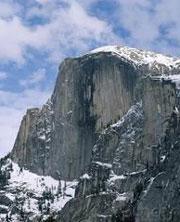 This pluton ain't on Pluto: Yosemite National Park's Half Dome is called a pluton by geologists.Punchstock
This pluton ain't on Pluto: Yosemite National Park's Half Dome is called a pluton by geologists.PunchstockOn 16 August the International Astronomical Union (IAU) floated a proposal for a definition of the word 'planet', in part to end the confusion about whether Pluto is a planet or not. But their solution, which assigns Pluto and its neighbours to a subset of planets called 'Plutons', is so far just creating more confusion and angst.
Scientists have pointed out that the word 'pluton' is already taken by geology, making at least one geologist hopping mad. Furthermore, astronomers have argued that the definition just doesn't fit with their intuitive sense of what a planet is — leading, already, to a second proposed definition. The confusion will probably continue until this Thursday, at least, when IAU members will put the proposals to a vote.
Plutons, under the first IAU draft definition, would be round astronomical objects that take more than two centuries to orbit the Sun. That, broadly speaking, includes most objects in the Kuiper belt, a ring of large debris beyond the orbit of Neptune.
But a pluton in geology is a large bubble of molten rock that solidifies underground, points out Allen Glazner, a geologist at the University of North Carolina at Chapel Hill who has devoted a decade of study to the stuff. On 18 August, Glazner wrote a letter to the IAU accusing them of "hijacking our perfectly good [definition] and causing endless confusion."
“This would be like if botanists had found something between trees and bushes and invented the word 'animal' to describe it.”
Allen Glazner,
University of North Carolina
Plutons are common in geology, Glazner says. "It's what the Earth's crust is constructed from, especially the continental crust," he says. "It's really, really fundamental." They're not too hard to find either. For example, Yosemite National Park's Half Dome, in California, is a pluton that became exposed after it formed beneath the Earth.
"This would be like if botanists had found something between trees and bushes and invented the word 'animal' to describe it," Glazner says.
Spell checked
Owen Gingerich, an astronomer at Harvard University in Cambridge, Massachusetts, and chair of the IAU committee that created the definition, says that they were aware of its usage amongst geologists, but unaware of its importance to the field. "Since the term is not in the MS Word or the WordPerfect spell checkers, we thought it was not that common," Gingerich wrote in an e-mail to news@nature.com. The geologic definition of the word does appear in common dictionaries, including the Oxford English.
Gingerich says that he believes the two definitions can coexist, "We think words can (and frequently do) have alternative meanings - for example, is there mercury on Mercury?" he says. He adds that he is willing to consider alternative terms to describe Pluto-like objects.
ADVERTISEMENT
But Glazner disagrees. "If it was two really different fields it might not matter, but planetology and geology are really close," he says. "It would be amazingly confusing."
The argument could potentially be solved if the IAU decides to change its mind entirely about the definition of a planet. The 16 August proposal — the one that originated the term Pluton — defined a planet as any body in orbit around a star that is not a star itself nor in orbit around a much larger planet, and that is massive enough for gravity to have squished it into an approximately spherical shape.
On 18 August a new proposal was mooted, adding that the object also needs to be by far the largest object in its local population. This would leave our Solar System with just eight true planets, downgrading Pluto to a proposed 'dwarf' planet.
Follow the debate on our reports/internationalastronomical_union/">newsblog .
University of North Carolina
